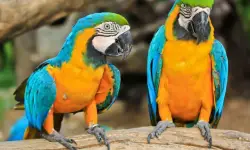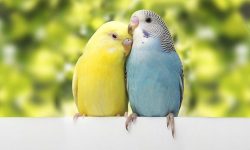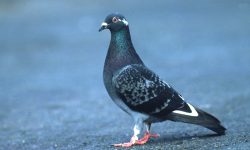Purple parrots, with their dazzling plumage ranging from lavender to deep violet, are some of the most unique and enchanting pet birds in the avian world. While not a single defined species, “purple parrots” is a term often used to describe several parrot types with purple or purplish-blue feathers, including color mutations of Indian Ringneck Parakeets, Violet-Necked Lories, Hyacinth Macaws, and selectively bred Budgerigars. Their rare coloration and charming personalities make them popular among bird enthusiasts, but their care requires more than admiration—it demands understanding, dedication, and informed action.
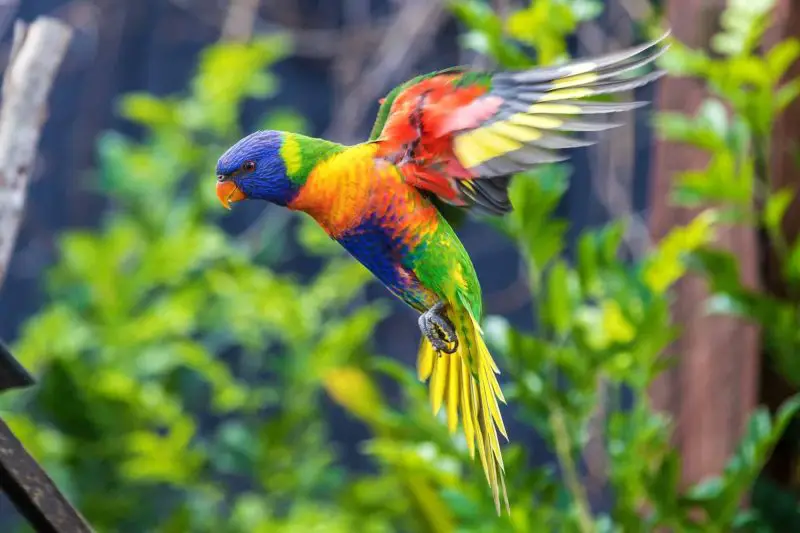
Understanding Purple Parrots
Not a Species, but a Spectrum
The term “purple parrot” might sound like it refers to a single, exotic species with naturally violet feathers, but in truth, it represents a far more diverse and fascinating group of birds. Scientifically speaking, “purple parrot” is not a formal taxonomic classification, but rather an informal label used to describe various parrot species and color mutations that exhibit hues of purple, violet, lavender, or bluish tones. These striking colors can result from natural pigmentation in the wild or be the product of selective breeding and genetic manipulation in captivity.
Among the most well-known examples is the Violet Indian Ringneck Parakeet, a domestic variant with rich purple plumage that arises from recessive color mutations. These birds do not occur naturally in the wild but are carefully bred by aviculturists seeking to enhance their rare and vibrant coloring. Their bold appearance, along with their ability to mimic human speech and develop strong bonds with caregivers, has made them a favorite among exotic bird enthusiasts.
Another bird often grouped under the purple parrot label is the Violet-Necked Lory (Eos squamata riciniata), native to the Maluku Islands in Indonesia. This species is mostly bright crimson, but it features bold violet patches on its neck and wings, which are entirely natural and serve social and mating functions in its native environment. Unlike the selectively bred Ringneck, the Lory’s coloration is a product of evolution, not human intervention.
The Hyacinth Macaw (Anodorhynchus hyacinthinus), the world’s largest parrot, is another remarkable bird that occasionally appears purplish in certain lighting conditions. Though typically cobalt blue, its feathers can shimmer with a violet iridescence, especially in natural sunlight. Native to South America and currently endangered, the Hyacinth Macaw is also one of the most regulated parrot species due to its rarity and ecological importance.
For those seeking a smaller, more accessible purple parrot, Purple Budgerigars—often called “budgies”—are a popular choice. These parrots do not exist in the wild but are bred in captivity through complex genetic combinations, including the blue series, violet factor, and opaline mutation. The result is a stunning range of pastel lavender to deep plum hues, making them one of the most visually charming yet manageable parrots for home environments.
Understanding that “purple parrot” refers to a spectrum of birds rather than a single species is critical for proper care. Each type of purple parrot—whether naturally pigmented or genetically bred—has distinct dietary, behavioral, and environmental needs. Indian Ringnecks do well on a varied diet of fruits, vegetables, grains, and seeds, while Lories require nectar-based nutrition due to their specialized digestive systems. Hyacinth Macaws have high fat requirements, especially from nuts like Brazil nuts and macadamias, to maintain their strength and feather health.
Beyond diet, knowing the species also helps predict temperament, noise levels, social needs, and lifespan. Some purple parrots, like Ringnecks and Lories, are highly vocal and need frequent mental stimulation and interaction. Others may prefer quiet environments or more independent routines. Misidentifying the bird can lead to improper care, stress, and even health complications.
In conclusion, the term “purple parrot” is more poetic than scientific, but it reveals a colorful spectrum of species and mutations that each require unique understanding and care. Whether you’re fascinated by genetics, bird behavior, or simply love their vibrant appearance, recognizing the origin and traits of your purple parrot is key to responsible and rewarding bird ownership.
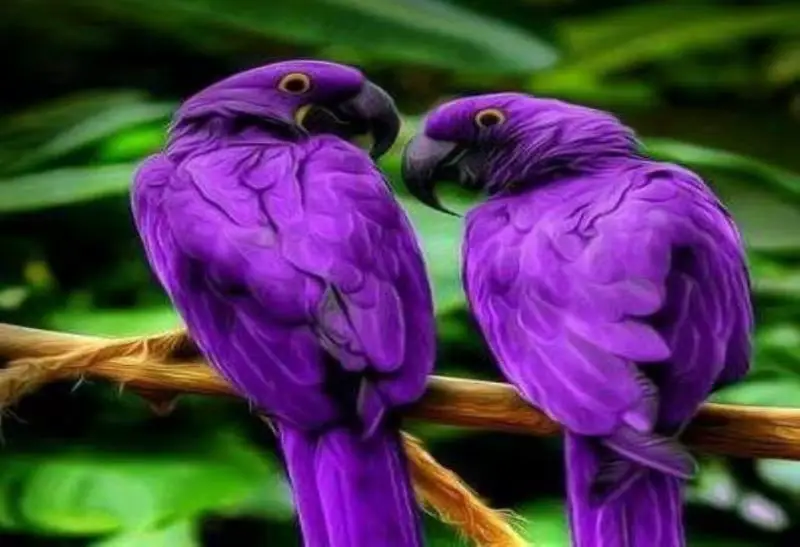
Intelligence and Social Complexity
Parrots, including those categorized under the vibrant umbrella of purple parrots, are renowned for their exceptional intelligence and emotional depth. Scientifically, parrots rank among the most cognitively advanced non-human animals, with abilities that often surpass those of dogs and rival those of primates. Their large brains, particularly the nidopallium caudolaterale—the region associated with executive functions—enable them to engage in tasks that require memory, logic, learning, and communication.
Purple parrot varieties such as the Violet Indian Ringneck, Hyacinth Macaw, and Purple Budgerigar exhibit many of the hallmark traits of avian intelligence. They can mimic human speech, recognize patterns, solve complex puzzles, and even identify themselves in mirrors, indicating a level of self-awareness that is rare in the animal kingdom. These birds are capable of associating words with meanings and sometimes use them contextually, showcasing not just imitation but comprehension.
However, this remarkable intelligence is a double-edged sword. In the wild, parrots stay mentally engaged by foraging over large areas, navigating intricate social structures, and responding to constantly changing environments. In captivity, the lack of natural mental stimulation can quickly lead to psychological distress. Boredom and loneliness often manifest in destructive behaviors such as feather plucking, excessive screaming, aggression, or repetitive movements. These behaviors are not mere disobedience—they are symptoms of cognitive deprivation.
To thrive, purple parrots require daily mental stimulation and social interaction. Enrichment can take many forms: foraging toys, trick training, speech interaction, or simply spending time outside their cage to explore. Many parrots even enjoy listening to music, watching videos, or playing interactive games with their owners. Ignoring their intellectual needs is not just detrimental to their well-being—it can shorten their lifespan and erode the bond between bird and human.
Equally important is their social complexity. Parrots are flock animals by nature, forming lifelong bonds with mates and developing hierarchies within their groups. In captivity, they often transfer that bond to their human caregivers. Without regular interaction and affection, a purple parrot can suffer from emotional distress, which in turn affects their physical health. Understanding and respecting their need for companionship is essential for building a healthy, trusting relationship.
Ultimately, the intelligence and emotional sophistication of purple parrots make them deeply rewarding pets for experienced bird owners—but also demand consistent effort, empathy, and enrichment. Caring for such a bird means not just meeting its physical needs, but also nurturing its brilliant and sensitive mind.
Diet: Fueling Their Vibrancy and Health
Base Diet: Pellets and Variety
A healthy diet is essential for the long-term well-being of any purple parrot, regardless of its species or color mutation. Commercial pellets should form the core of their daily nutrition. These pellets are scientifically formulated to provide balanced levels of vitamins, minerals, protein, and essential amino acids, helping prevent common health issues like vitamin A deficiency, obesity, or poor feather condition.
However, no pellet can fully replicate the complexity of a wild parrot’s diet. In nature, parrots consume a wide variety of foods—fruits, vegetables, seeds, nuts, flowers, and sometimes insects. To mimic this diversity and stimulate natural foraging behavior, pellets should be supplemented with fresh produce and whole foods. Offer seasonal fruits like papaya or apple, vegetables such as leafy greens and bell peppers, and healthy grains or legumes like quinoa and lentils.
Different types of purple parrots may have species-specific dietary needs. For example, Lories and Lorikeets require nectar-based diets and cannot digest standard pellets, while Hyacinth Macaws need high-fat nuts like macadamias and Brazil nuts to thrive.
Seeds should be limited to occasional treats, as they are high in fat and low in nutrients. Also, avoid toxic foods like chocolate, avocado, caffeine, and anything salty or sugary.
In short, the best diet combines nutritionally complete pellets with a variety of fresh, species-appropriate foods, supporting both physical health and mental enrichment for your purple parrot.
Fresh Produce
Fresh fruits and vegetables are an essential part of a healthy diet for any purple parrot. They provide nutrients that pellets alone cannot fully offer and play a key role in supporting immune function, digestion, and feather condition.
Leafy greens like kale, spinach, and romaine lettuce are excellent sources of calcium and antioxidants, promoting strong bones and reducing inflammation. Colorful vegetables such as carrots, bell peppers, and sweet potatoes are rich in vitamin A, which is vital for maintaining healthy skin, vision, and vibrant plumage.
Fruits like papaya, mango, blueberries, and strawberries offer natural vitamins, fiber, and hydration. Most parrots enjoy their sweet taste, but because of their natural sugar content, fruits should be given in moderation—as treats rather than staples.
Including a daily mix of fresh produce not only boosts physical health but also encourages natural foraging behavior, which is important for your bird’s mental stimulation and well-being.
Grains and Legumes
Grains and legumes are valuable additions to a purple parrot’s diet, offering essential carbohydrates, plant-based proteins, and dietary fiber. Cooked options like brown rice, quinoa, lentils, and beans help support energy levels, muscle maintenance, and digestive function.
Including a variety of these foods several times a week can enhance both nutritional balance and mealtime enrichment. Additionally, soaking or sprouting seeds and legumes before serving increases nutrient absorption and promotes gut health, mimicking natural foraging conditions and improving overall digestion.
Treats and Cautionary Foods
While occasional treats can enrich a purple parrot’s diet, they must be chosen with care. Nuts such as almonds, walnuts, and pistachios are rich in healthy fats and beneficial nutrients, but their high calorie content means they should be offered sparingly, especially for smaller species prone to weight gain.
At the same time, certain foods must be strictly avoided, as they are toxic to parrots. These include avocado, chocolate, caffeine, alcohol, and any foods that are salty, sugary, or heavily processed. Even small amounts can lead to serious health issues, including liver failure or death.
Keeping treats healthy and safe is key to maintaining your parrot’s long-term wellness and avoiding preventable health risks.
Hydration
Proper hydration is essential for the health of any purple parrot. Clean, filtered water should be available at all times and must be changed daily to ensure freshness and prevent contamination.
Water bowls should be scrubbed regularly to eliminate bacteria, algae, or mold—especially in warm or humid environments. Stainless steel bowls are strongly recommended over plastic, as they are more durable, easier to sanitize, and less likely to harbor bacteria in scratches or worn surfaces.
Consistent access to fresh water supports digestion, temperature regulation, and overall immune function, making it a vital—but often overlooked—part of daily parrot care.
Habitat: Designing a Home for Flight and Freedom
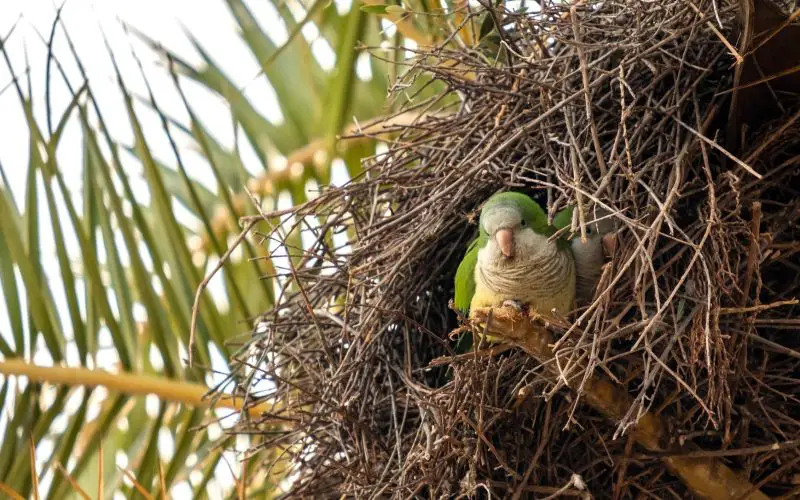
Cage Size and Construction
An appropriately sized cage is essential for the physical and mental health of any purple parrot. These birds need ample room to move, stretch their wings, and engage in natural behaviors. A cramped cage can lead to muscle atrophy, boredom, and stress-related behaviors like feather plucking.
The cage size should be proportional to the bird’s species and activity level. Larger parrots like Hyacinth Macaws require walk-in aviaries or very spacious enclosures, while smaller species like budgerigars can thrive in well-designed medium-sized cages—with plenty of time outside for exercise.
Horizontal bars are ideal, as they encourage climbing and exploration, especially for parrots that enjoy scaling the sides of their enclosure. Proper bar spacing is crucial for safety: typically 0.5 to 1 inch, depending on the bird’s size, to prevent them from getting their head or limbs stuck.
A well-constructed cage made from stainless steel or powder-coated metal ensures durability, hygiene, and safety—key factors in long-term parrot care.
Location and Lighting
Where you place your purple parrot’s cage has a significant impact on its well-being. These birds are highly social, so cages should be located in active areas of the home—such as living rooms—where they can observe and interact with daily household activity. However, avoid placing cages in kitchens due to fumes and sudden temperature changes, or in drafty areas that may cause illness.
Natural light exposure is crucial for maintaining a healthy circadian rhythm and supporting mood and metabolism. Parrots should receive 10–12 hours of daylight-like exposure each day. For birds kept indoors without direct access to sunlight, consider using full-spectrum UVB lighting to help them synthesize vitamin D3, which is essential for calcium absorption and bone health.
Proper placement and lighting not only improve physical health but also help regulate sleep cycles and reduce stress-related behaviors.
Enrichment
For purple parrots, mental stimulation is just as important as physical care. Without regular enrichment, intelligent birds can develop boredom, anxiety, and harmful behaviors like screaming or feather plucking.
Provide a variety of toys designed for chewing, shredding, foraging, and problem-solving to engage their natural instincts. Items like wooden blocks, puzzle feeders, paper strips, and safe branches allow parrots to explore, play, and stay mentally sharp. To prevent boredom, rotate toys weekly so the environment remains fresh and stimulating.
Mirror toys may offer a sense of companionship for birds housed alone, but they can sometimes trigger obsessive or territorial behaviors. Observe your bird’s reactions carefully and remove mirrors if they cause agitation.
Consistent enrichment not only supports cognitive health but also strengthens your bond with your bird through interactive play and positive engagement.
Cleanliness
Maintaining a clean environment is vital to a purple parrot’s health and longevity. A dirty cage can harbor bacteria, mold, and parasites, leading to respiratory infections and other serious illnesses.
Replace bottom liners or bedding daily to control droppings and moisture. Perches, food bowls, and toys should be disinfected weekly using bird-safe cleaning products. Avoid aerosol sprays, bleach, or other harsh chemicals, as parrots have extremely sensitive respiratory systems.
Regular cleaning not only prevents disease but also creates a more comfortable, stress-free living space—supporting both physical and emotional well-being.
Personality: Building a Bond with Your Purple Companion
Individual Temperaments
Purple parrots are not a single species, and each type comes with its own unique personality traits. Understanding these differences is key to building a strong bond and providing the right care.
Budgerigars are small, playful, and sociable, making them ideal for beginners. They are quick learners and often enjoy gentle interaction and basic trick training.
Indian Ringnecks are known for their intelligence and clear speech, but they can be independent and experience mood swings, especially during hormonal periods.
Lories and Lorikeets are high-energy and highly vocal, thriving on social interaction and play. However, they require a specialized nectar-based diet, making them more demanding to care for.
Hyacinth Macaws and other large macaws are deeply affectionate, expressive, and often form strong emotional bonds with their caregivers. They need lots of attention and mental stimulation, and may become destructive if bored or neglected.
Recognizing your bird’s temperament helps tailor socialization, training, and daily routines to fit its natural behavior—ensuring a happier and more balanced life for both bird and owner.
Social Needs
Purple parrots are deeply social flock animals that thrive on companionship. Isolation can lead to emotional distress, which often manifests as screaming, biting, or feather plucking.
To meet their social needs, provide daily interaction through talking, singing, supervised out-of-cage time, and clicker training. For tame birds, gentle physical contact like head scratches strengthens trust and emotional bonds.
Neglect or lack of stimulation can result in behavioral problems. Always respond to negative behaviors with patience and positive reinforcement, never punishment. A socially fulfilled parrot is happier, healthier, and easier to train.
Communication
Purple parrots are expressive birds that rely on a combination of vocalizations, body language, and behavioral cues to communicate. Understanding these signals is essential for building mutual trust and preventing misunderstandings or aggression.
Common signs include fluffed feathers (comfort or agitation), eye pinning (excitement or focus), and tail fanning (warning or defensiveness). Vocal cues—ranging from chirps and squawks to mimicked words—reflect mood, needs, or social interaction.
By learning to read your parrot’s communication style, you’ll strengthen your bond, respond appropriately to its needs, and avoid unnecessary stress or conflict.
Health and Veterinary Care
Annual Checkups
Routine veterinary care is crucial for keeping your purple parrot healthy and thriving. Schedule a visit with an avian veterinarian at least once a year for a full wellness exam.
Annual blood tests can detect early signs of nutritional deficiencies, organ dysfunction, or underlying infections—often before symptoms appear. These proactive checkups are key to preventing serious illness and extending your bird’s lifespan.
Make sure your vet has experience with exotic or avian species, as parrots require specialized knowledge and care not all general veterinarians can provide.
Common Illnesses
Purple parrots are masters at masking discomfort, so subtle signs like lethargy, fluffed feathers, wheezing, changes in droppings, or a sudden loss of appetite should never be ignored. Among the most frequent health issues are Psittacosis, a bacterial infection that affects the respiratory system and can spread to humans; Aspergillosis, a fungal lung infection often linked to poor ventilation or dusty conditions; nutritional deficiencies caused by unbalanced diets lacking essential vitamins; and egg binding, a potentially life-threatening condition in female birds when an egg becomes stuck internally. Prompt veterinary care and accurate diagnosis are essential—early intervention often makes the difference between a full recovery and a medical emergency.
Grooming
Although purple parrots naturally preen to keep their feathers clean and aligned, they often enjoy gentle mist baths or light showers, which help remove dust and promote healthy plumage. With the right perches and chew toys, most birds maintain their nails and beaks on their own, but occasional trimming may still be necessary to prevent overgrowth. Wing clipping remains a controversial subject—some owners choose to clip for safety in indoor environments, while others advocate for full flight to support a bird’s physical exercise and mental stimulation. The decision should be based on your bird’s environment, personality, and safety needs.
Specialized Considerations for Purple Parrots
Color Mutation Sensitivities
Some purple-hued birds are the result of selective breeding, which may compromise genetic diversity. This can lead to reduced immune strength, increased sensitivity, and higher risk of deformities. Choose reputable breeders who prioritize health over appearance.
Breeding Ethics
Breeding parrots, especially color variants, should not be attempted without expertise. It involves genetic knowledge, proper facilities, and contingency planning. Accidental breeding can be prevented by identifying gender and housing birds responsibly.
Lifespan and Long-Term Commitment
Longevity by Species
Budgerigars: 5–10 years Indian Ringnecks: 20–30 years Lories: 15–20 years Macaws: 40–60 years
This is not a short-term pet. Many parrots outlive their owners. Be prepared for decades of responsibility, emotional investment, and expense.
Daily Commitment
Purple parrots require 1–2 hours of daily attention, regular out-of-cage time, and continuous enrichment. Budgeting for toys, high-quality food, and vet bills is essential.
Conclusion: A Rewarding Journey
Caring for a purple parrot is a commitment of time, patience, and love. These birds offer more than stunning feathers—they bring joy, companionship, and a unique bond that can last a lifetime. By understanding their needs and investing in their well-being, you ensure your purple companion thrives not just in captivity, but in partnership with you.
Whether you are a first-time bird owner or an experienced avian enthusiast, the effort you pour into your parrot’s life will be returned a hundredfold in affection, entertainment, and connection. Treat them not just as pets, but as sentient beings deserving of a rich, fulfilling life.

